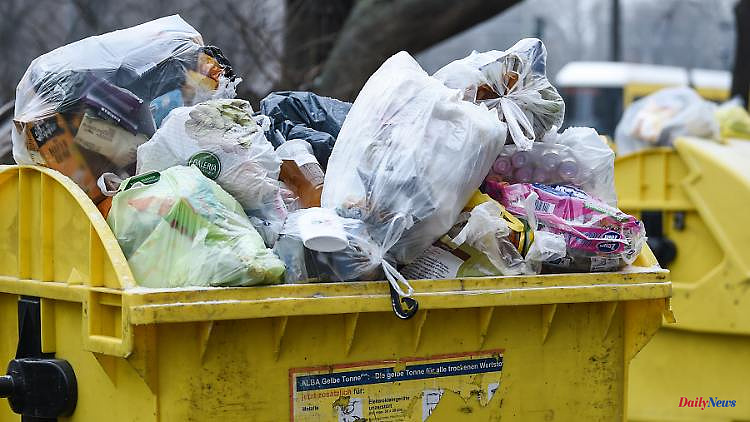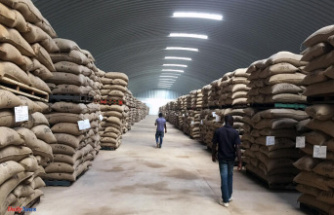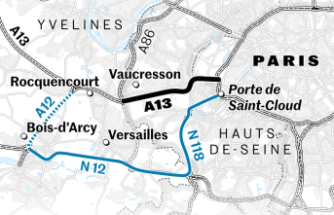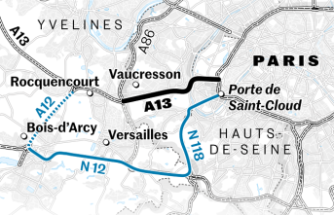Sebastiaan Krol dreams of a world without waste. But we are still a long way from that, even if the German recycling system is already "state of the art", as the head of the waste service provider Interzero explains in the "climate laboratory" of ntv. To date, only 60 percent of all packaging waste is recycled. However, the native Dutchman is convinced that with the right materials, a complete circular economy is possible - if the packaging industry and food retail trade follow a simple basic rule when developing new packaging: the more homogeneous the packaging material, the easier it is to recycle. This applies at least to the areas in which packaging is indispensable. Because "the best way to avoid waste is by preventing it from occurring in the first place," says the recycling expert. Then you only have to drive consumers out of "intelligent mistakes".
ntv.de: The vision of you and Interzero is a world without waste. How does that work?
Sebastiaan Krol: We are currently experiencing two things. On the one hand, thank God, we are moving away from the basic idea of a linear economy. I find it very positive that most people have realized that we can no longer continue as we have in the last 20, 30 or even 50 years, but that we need a circular economy. This circularity arises precisely when you prevent an object from becoming garbage in the first place. With many products and material flows, you can already realize that in the end nothing is thrown away, but reused in some form - whether you recycle or recycle it. That's what we stand for.
And in this way you can ultimately avoid any garbage?
We believe that this is possible with a few exceptions. Of course there is still very dangerous waste and things around the world that are not necessarily suitable for recycling. But if you look at the types of capital goods that the world typically produces, you can put a very large proportion of them into circulation.
But do consumers still have to throw away and recycle their waste at home? Or is the goal that you no longer need garbage bags?
Both. Most people forget this, but the best way to avoid litter is by preventing it from being created in the first place. If that's not possible, at the end of life you look to see if you can reuse it in any way. Only when these two options have been ruled out do you come to the third point and consider: How can I recycle this? Certainly with the aim of avoiding thermal recycling. That doesn't happen in a circular economy anyway. We are not here to fuel incinerators.
But how is that supposed to work in the supermarket? Almost everything we put in the shopping cart is packaged. Sometimes even fruits and vegetables. Fresh goods such as sausage anyway.
For many goods there are sufficient opportunities to buy them unpackaged. This is the royal road. Then you simply avoid having to bring something back. From January 1, 2023, the new legal requirement that takeaway food must be offered in reusable packaging will also apply.
coffee for example?
Exactly. Coffee or typically the salad at the bar or the sliced pineapple. Sausage isn't one of them, but even with those foods that need to be packaged, in the end it's relatively simple: you need to make sure the packaging is easily recyclable. Plastics can be recycled very well if you do it sensibly. This is a shared responsibility between us and the food industry. Then it is up to the consumer to make sure that they are separated properly. From my perspective, if they do that, everything that needs to be done to dispose of it ecologically is done.
It sounds like we're on the right track. Overall, the amount of garbage is still frightening. How far are we with this vision of a world without waste?
I'm always a friend of frank words and of not pretending anything. What we are doing here and now in Germany is "state of the art". When it comes to sorting and recycling, we use the absolute maximum. But these recycling processes have technical limitations. If you empty a Yellow Bag and sort it, you can get a certain quota, but some things just don't work technologically. But what I still look at with suspicion is the situation outside of Germany. You will find countries relatively quickly where there is no yellow bag and no deposit system. Then you won't achieve a recycling rate of 60 percent like in Germany, but will quickly end up in the single digits.
But even with "state of the art" recycling, you only achieve a rate of 60 percent?
This wasn't an attempt to shirk responsibility. We are represented with Interzero in ten European countries and bear responsibility for catching up with Germany in Poland, Italy, Croatia and other countries. We are working on this together with the municipalities, the member states and our customers.
But even a good recycling rate of 60 percent is far from a world without waste.
It's like a combustion process. You will never achieve 100 percent efficiency there either. And believe it or not, the yellow sack rate varies by state, weather, and so on.
How does the weather affect trash?
This is changing people's consumer behavior. For example, watermelons are only bought when the weather is good.
To eat by the lake or pool?
Exactly. The same goes for the bratwurst. It is bought with preference if it can be grilled. But let's get back to the yellow bag: you will always find waste in it that cannot be recycled. This can be food leftovers, but also incorrect throws. In Germany there is even a term for the phenomenon, the so-called "intelligent misjudgment".
You have to explain that.
With pleasure. There are people who think the Yellow Bag is for plastics. It is not so. The Yellow Bag is intended for packaging or materials intended for this purpose. Let's take a bobby car: that thing doesn't belong in the yellow sack. If it is thrown in anyway, one speaks of an "intelligent misthrow: The basic idea is not wrong, but it is not right either. You have a lot of it. But you will never be able to prevent it. It is part of the system.
Shouldn't the system be changed then?
There is definitely a better way to educate consumers about what belongs in a yellow bag and what doesn't. We are trying to do this through the Association of the German Waste Management Industry.
But isn't the system really a bit complicated? Everyone knows the case that you have to think three times about which garbage belongs in which bin or sack.
There is certainly room for improvement in labeling what goes where. However, this not only applies to the labeling of the materials, but also to the identification of what has ended up in the bin or sack. Approaches vary, but no matter how, you have to use a very high level of engineering to investigate what type of plastic was thrown in there. A better way of solving this is with markers or other methods that don't require you to try to measure what plastic it is.
Does that mean that there are still many ways in Germany to improve the recycling rate or to reduce the amount of waste overall?
Yes. Our sorting system works with the most modern sensor technology in the world and gets out what you can get out of it - partially also in a post-sorting process. In that respect, we're really on the right track. Improvements can still be made, but these are not ten percent jumps, but a few percentage points here, a few percentage points there. But it would really make the most sense if you no longer had to measure what kind of plastic it is, but simply write it down.
That would be an idea.
We are already working with the packaging industry and other distributors to ensure that something like this becomes established in the next few years. That would be good for the recycling rate.
Are the packaging and food industries doing a good job in this area?
The question is of course a bit difficult (laughs). In any case, the packaging industry and food retail trade have now reached a point where it is clear: we cannot continue as before. We need to worry about circularity and recyclability. I don't mean to be defensive of the packaging industry, but you also have to know that they have two tasks: They have to design attractive and reasonably recyclable packaging. However, it must also ensure that the food is packaged securely. Sometimes that's a trade off. It's good to design packaging that's easy to recycle, but then the food inside doesn't last as long. What's better for the environment now? Some packaging is designed to keep the ground beef 10 days longer. That's still better for the environment than perfectly recyclable packaging, where you have to throw away the meat five days earlier.
Are there still things that really annoy you? Packaging where you say: it just doesn't have to be?
Absolutely. I'm always wary of openly criticizing good intentions that haven't been implemented properly, but as an example, if you want to recycle something, the very simple rule of thumb is that the more homogenous the product, the easier it is. No matter what it's about. If the packaging is made of only one material, it is easy to recycle.
So if possible only paper, only plastic or only aluminium?
Exactly. Especially with mixed plastics, you have to make sure that you use the same types. Because they are otherwise difficult or impossible to recycle. Or only with an enormous effort. But of course there are many manufacturers who say: I want sustainable packaging. Then they sometimes generate hybrid packaging that is part plastic and part paper.
Where does it say that they contain 90 percent less plastic?
Correctly. The problem with this is that you can never separate the paper from the plastic. That's why the thing is going to incineration. If it had been old plastic packaging, it could have been recycled.
And how often does this type of packaging occur?
I don't have any statistics ready. It's not a big amount either. The ulterior motive is also correct, but implemented incorrectly. We're not helping anyone with that. The most important thing is, and this is our appeal: if you want sustainable and easily recyclable packaging, you should consult an expert who knows how things are sorted and processed. Then you create something really good and not just a packaging where you can write "50 percent less plastic" on it.
Are the incentives for the so-called distributors big enough to really change something? Or does it need new political rules?
We are doing relatively well on European soil. If you look at the development of the recycling rate in the plastics sector, you will see that we have improved significantly in recent years and will continue to improve in the future. This doesn't happen because we put more effort into sorting, but because the industry is held accountable.
Regarding your vision, the world without waste: when will it be ready?
The question is more than justified, but unfortunately I will not answer it. When will the world be completely waste-free? I don't have enough PhDs in economics and the like for that. But I can promise you that in certain waste streams we're not that far from this goal.
And if you're a vegetarian, you don't have to worry about the sausage packaging.
Correct!
Clara Pfeffer and Christian Herrmann spoke to Sebastiaan Krol. The conversation has been shortened and smoothed for better understanding.












